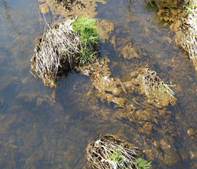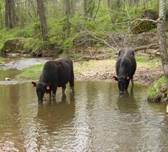

Overseeing the Water Resources of Loudoun County, VA
Agricultural Impacts
In the U.S. agriculture runoff accounts for approximately 60% of the nonpoint source pollution. Inadequate crop and livestock farming practices add significant amounts of nutrients and sediments to the runoff that enters the streams. Problems result from converting forested floodplains and wetlands to agricultural land; overgrazing; allowing livestock to trample riparian vegetation, stream banks, and stream habitats; and not providing a tree and shrub buffer between crops and waterways.

Sediment bank NF Goose Cr.

Algae on rocks in Beaverdam Run
Fecal Pollution -- Wastes from warm-blooded animals including human sewage, and livestock release disease-causing organisms into streams. Fecal coliform bacteria are used to indicate the potential presence of human pathogens and the likelihood of a public health threat. Higher concentrations cause greater public health concerns. DEQ considers recreational waters to be impaired or unsuitable for use when water samples collected over a 2-5 year period are greater than an average of 126 E. coli colonies per 100 ml of sample (EC MFN/100ml).

Cows in Limestone Branch
info@loudounwatershedwatch.org Copyright © 2011 Loudoun Watershed Watch